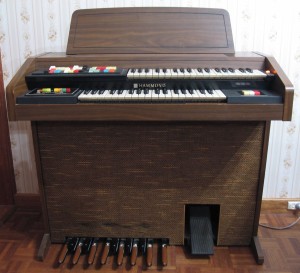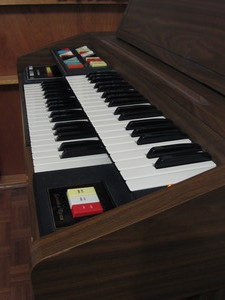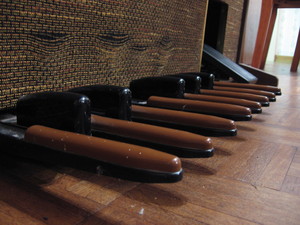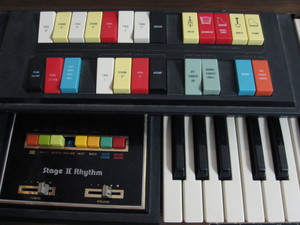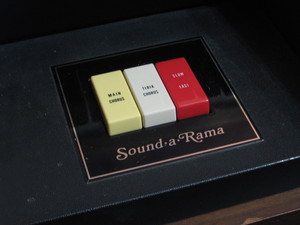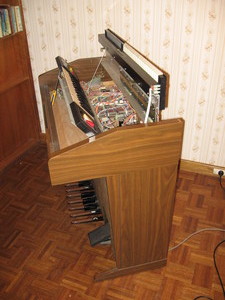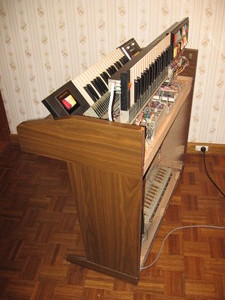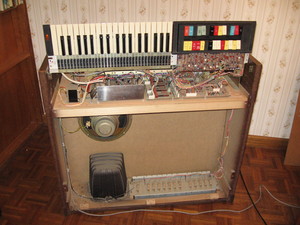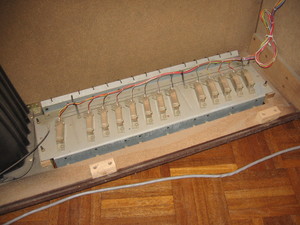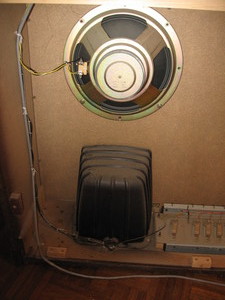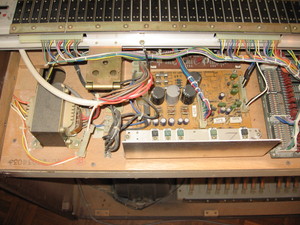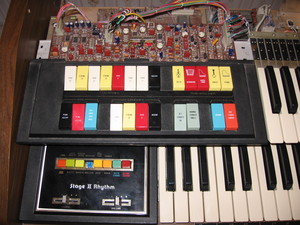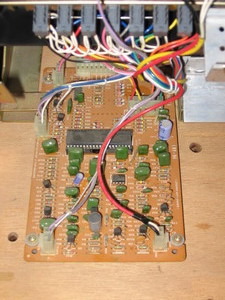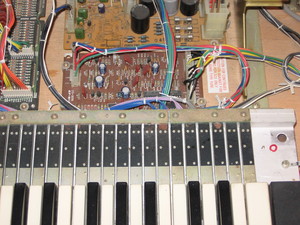The first organ we owned was a Hammond 123J3, it's pretty much of a baby organ, with few voices and effects. It was a reasonably good organ to learn to play on, not too simple, not too fancy, but you outgrow it soon enough—there's not enough voices, not enough effects, the keyboard manuals and the pedal board are all too short on notes. The pedal board's also a bit too short on length, you can see where my toes have caught the speaker cloth and dragged it down in a few places (actually, upon reflection, I don't remember poking the board with my toes, so I blame someone else for clumsy footwork, nyah).
We got this, new, in 1981, and still have it, though it's getting a bit tempermental with age (noisy switches, failing Sound-a-Rama faked Leslie). Later on I got a small portable Technics keyboard, and sat it on top. But I never found reaching that high up very comfortable, and I eventually traded it in when I bought a better console organ (probably when I bought my Yamaha D30, I'm fairly sure I got rid of it before I bought the Technics U90).
The faked Leslie was particularly lousy, with just amplitude modulation. But the vibrato was pretty good, much better than the vibrato on many other organs, the speed and depth gave it a nice purr. It'd be moderately easy to modify the organ to use a real Leslie, as the switches to use the fake Leslie directly switch the audio signal paths for the upper and lower manuals, and the pedals wouldn't be too hard to break out, too.
It was an all transistorised, and integrated circuitry organ. No valves, no tonewheels. It didn't have flute voices, it had tibias. They're somewhat similar, but the timbre tends towards the clarinet than the flute, with a bit of a brighter harmonic to it. There were four tibias, so you could have bright, mellow, and strong flute sounds, but none of the more interesting harmonics between octaves. The strings are a bit paper-comb sounding, they don't sound like real strings, nor even the string sounds of pipe organs. The horn's not a vibrant one, more reedy than trumpety. The cello and according instrument voices sounded more like musical wheezing than the instruments that they claimed to be. The piano is a rather lame electric piano copy, the harpsichord being just passable, but both had poor switching—if you were to hold down a note, then strike another key, the previous note would fire off again with the new one (e.g. hold down E, then hit C, and both E and C would fire off as if just struck; now hit G, and E and C would fire off, again, with G). But, unlike the eight-note polyphony of my Technics, this organ will play as many notes as you can hold down at a time (full polyphony), you can do a keyboard slide with the sustain turned on.
The rhythm unit was reasonably okay, though a bit limited, quite brutal in its sound, and you didn't have a kick switch to start/stop it with your foot. You could play your own chords and pedals, or let the rhythm unit play pedals for you as you played chords (it'd modulate the chords between playing the pedals). There was also a one-finger-chord feature, but you only had a limited number of chords that it could play. Unlike other models, where you might use one finger to play an F chord, then do something else to make it a minor or diminished, you just used one key on one octave of the lower manual to play the major chords (C up to B flat), with a few minor chords and one diminished chord (F sharp) on part of another octave of the manual. Anything else, and you were out of luck, you'd just have to learn to play the chords, yourself.
The sound quality was reasonably okay. It didn't get very loud, though loud enough to make one neighbour complain. But the quality suffered from the only speaker in the cabinet being one large woofer. I had tried connecting an external speaker, but that sounded worse. It sounds like they'd boosted the treble to compensate for there being no midrange nor tweeter, and the organ cabinet is an integral part of the sound generation. To use an external speaker with an organ, you need to use one that's designed for that purpose.
Supposedly it had full polyphony. While many home organs had limited polyphony, this one was supposed to have a chipset that was continously producing all the notes that every key played, so it emulated the way a tonewheel generator worked (though it certainly didn't have the same timbre).
In an experimental sense I can probably confirm that. You could hear all the notes continuously playing very quietly in the background. And if you lay your arms across the keys, you could make them all sound, with no notes disappearing as you pressed more keys.
This might also explain the very simple circuitboard behind the registration switches (it's mostly a signal mixer, rather than doing any waveshaping). Very little filtering would be needed if each key switched on the generated note as it was meant to sound (lots of other organs filtered squarewaves down to produce other timbres). You just use some logic circuits for switching notes on and off, and playing the same note in different octaves as you selected the different footages.
I've seen a few slightly different models on the internet all described as the 123J3 (less voice tabs, and differently laid out switches). I can say this model is definitely badged as being 123J3. I don't know if the others really were, as well, though I'd have expected them to be differently named. There's a 123XL pictured in one of the books which came with it, it's almost identical, with all the same features, just fancier furniture.
You can listen to a sound sample of the Hammond 123J3, but the sample quality is very poor, I only had a Canon A520 digital still camera to hand, and it doesn't do sound very well.
| Upper: | 16′, 8′, 4′, 2′ tibia 16′, 8′ strings 8′ horn sustain cello, accordian, harpsichord, banjo (reiterating), & piano |
|---|---|
| Lower: | 8′ tibia 8′ string 8′ horn accent (increased lower-manual volume) |
| Pedal: | 8′ flute sustain accent (increased pedal volume) |
| Effects: | Faked Leslie effects with switches for flutes, strings & horns
(together), and fast/slow speeds. It affected the upper and
lower manuals, only. Vibrato (affecting all voices, including pedals), with normal/small variation switch. |
Various pictures of the Hammond 123J3
You can click on these images to see a larger view:
You may have noticed the same organ on Barry Morgan's world of organs website. It's not just the same make and model, they've borrowed the picture from my website (notice the various scuff marks, the switch positions, and the missing button on the rhythm unit). It's on the bottom of his homepage, just above the copyright notice. I was quite amused when I noticed that. But he's welcome to use my photo, I thoroughly enjoyed watching his appearances on Spicks and Specs.
